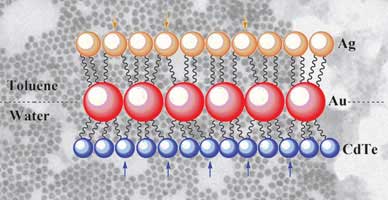| Posted: June 11, 2007 |
Two-faced fluids aid nanolayer synthesis |
|
(Nanowerk News) Scientists have made multilayered films of inorganic nanoparticles with the help of DNA bases ("Stepwise interfacial self-assembly of nanoparticles via specific DNA pairing" – free access article).
|
|
A team of researchers, led by Dayang Wang, at the Max Planck Institute of Colloids and Interfaces, Potsdam, Germany, formed a layer of gold nanoparticles at the interface between water and toluene. By alternately changing the surface groups on the gold nanoparticles through specific pairing of functionalised DNA bases, Wang attached a layer of positively-charged cadmium telluride nanoparticles on the aqueous side of the interface and a layer of hydrophobic silver nanoparticles on the organic side.
|
 |
|
Layers of inorganic nanoparticles can be built up at the water-oil interface
|
|
Assembly of the nanoparticle films at the water-oil interface has several advantages over assembly on a solid surface. 'The Janus-faced character of the interface allows the assembly of both aqueous and organic particles together, combining the advantages of both aqueous and organic methodologies,' Wang explained. The films also have fewer defects, and cross-linking between the DNA bases and the nanoparticles makes them stronger.
|
|
Victor Chechik, an expert in functionalised nanoparticles from the University of York, UK, was impressed by the work. 'The use of the inherent asymmetry of a liquid-liquid interface to assemble asymmetric films is a very clever idea,' he said.
|
|
Wang hopes that he will be able to create multilayered films of nanoparticles across which charge or energy can be transferred. This could lead to advanced thin film devices, he said.
|
|
There are still some hurdles to overcome in the characterisation of the films. 'Due to the exceedingly tiny dimension of the nanoparticles, it is a formidable challenge to determine the multilayered structure of nanoparticle films at the water-oil interface,' said Wang.
|

